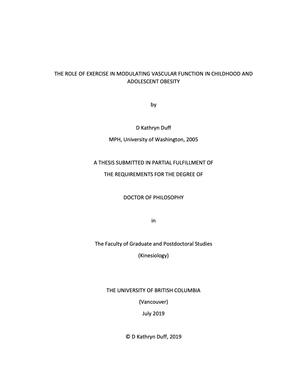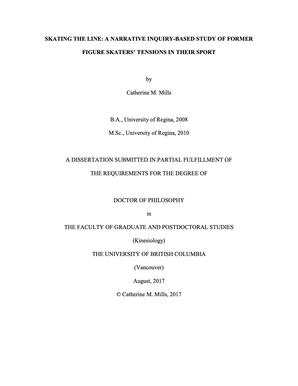University of British Columbia. Kinesiology
Related Works
Content type
Digital Document
Abstract
Purpose: Overweight children and adolescents have increased aortic stiffness conferring an increased risk of future cardiovascular events. This thesis evaluated exercise training as a means to modify aortic stiffness in obese youth. An institutional treadmill protocol (British Columbia Children’s Hospital, BCCH) for assessing metabolic gas exchange parameters (minute ventilation, tidal volume, breathing frequency, oxygen consumption, carbon dioxide production) was validated using a healthy cohort (study 1, Chapter 3). This protocol was used to test obese children and adolescents before and after an exercise intervention. Echocardiography was used to study changes to vascular properties pre- and post- training (study 2, Chapter 4). Pulmonary function tests were used to assess lung function pre- and post- training (study 3, Chapter 5). Study 1: A scaled institutional (BCCH) protocol was validated using 70 healthy boys and girls. This validated protocol was used in the subsequent training study to individually adjust intensity to V̇O2 capacity, in keeping with exercise intervention recommendations. Study 2: Ten to 18 year old children and adolescents (BMI ≥ 97th percentile for age) were recruited to undergo a 12-week exercise program in a randomized cross-over study. Standard echocardiographic dimensions and measures of systolic and diastolic cardiac function were recorded before and after both a 12-week exercise intervention and 12-week control phase. Biophysical properties of the aorta including pulsewave velocity were calculated using an echocardiographic-Doppler method. Treadmill exercise tests were also performed before and after each study phase. Study 3: The same participants that underwent the exercise training in study 2 were measured for resting pulmonary function and exercise spirometry as per the protocol described in the second study. Results: The institutional treadmill protocol produced similar peak exercises responses compared to the traditional protocol and was validated as an alternate for pediatric exercise testing. Ten participants completed the exercise intervention (age 14.3+3.2 yrs). Training showed a significant reduction in PWV (p=0.003), a modest reduction in body mass (p=0.0135), and exercise tolerance improved (METs, p=0.003; total exercise time, p=0.015). A reduction of aortic pulsewave velocity can be achieved with exercise training in obese children and adolescents and cardiovascular fitness can be modestly improved.
Origin Information
Content type
Digital Document
Abstract
Figure skaters skate a fine line as they navigate pressures to execute physically demanding, technical skills while maintaining the aesthetics of movements, appearance, and musicality. These conditions along with embedded narratives of success and performance affect the experiences of every competitive figure skater. As a former figure skater and coach, in this research, I explore the experiences of figure skaters and the inherent tensions they endure (Clandinin, Murphy, Huber, & Orr, 2009). Integrating theories and methods from organizational culture and narrative inquiry, my research explores the experiences of athletes within the culture of high-performance figure skating. I recruited seven former figure skaters (four female and three male) who had competed at a Senior Competitive level in Canada. The research followed three guiding questions: • What tensions do former figure skaters identify in relation to their experience as high-performance figure skaters? • How are these tensions related to the organizational culture of figure skating? • How do participants reflect on these tensions over time? Using artifacts to elicit conversations and reflections, I completed three to four interviews with each participant. I present their stories in a variety of narrative formats to better capture the feel of the interviews and their lived experiences. The figure skaters experienced multiple tensions across their careers as they embraced the lifestyle of a skater and during transitions away from the sport. Tensions included monitoring bodies, an overriding emphasis on competitions and winning, and the importance of music, choreography, and appearance in their overall performance as elite figure skaters. While many tensions were taken-for-granted as being a high-performance athlete, once removed from the sport, participants became aware of the sacrifices they had made and how some aspects of the culture had influenced their mental health and well-being. A critical analysis of the normalized aspects of the sport revealed an emphasis on performance deeply embedded across all levels of figure skating’s organizational culture (Schein, 2010). The dissertation highlights how participants became part of the problematic culture, accepting its localized terms and conditions which in turn served to reinforce and re-create the culture’s dominant values and norms (Alvesson, 2013; Smircich, 1983).
Origin Information
Content type
Digital Document
Abstract
Purpose: To determine the cardiovascular, respiratory, systemic inflammatory, and autonomic nervous system responses to varying exercise intensities during exposure to diesel exhaust (DE), and to determine how DE exposure before exercise affects the cardio-respiratory system and subsequent exercise performance. Methods: Eighteen males performed six 30-minute trials, which included rest, low-intensity, and high-intensity cycling. Each trial was performed twice, once breathing filtered air (FA) and once breathing DE (300ug/m³ of PM₂.₅) with seven days between trials. Before, and following exercise, exhaled nitric oxide, pulmonary function, heart rate variability, flow-mediated dilation (FMD), complete blood count, endothelin-¹ , and plasma nitrite/nitrate (NOx) were measured. During exercise, minute ventilation (VE), oxygen consumption (VO₂), CO₂ production (VCO₂), respiratory exchange ratio (RER), and rating of perceived exertion (RPE) for lungs and legs were measured. In a second experiment, eight males were exposed to DE (300ug/m³ of PM₂.₅) or FA for 60-minutes, followed by an indoor 20-km cycling time trial. Pulmonary function was assessed before and after exposure and after exercise. Heart rate was measured during exposure and exercise performance was measured as mean power output during exercise. Results: In the first experiment, RER was significantly lower (0.94 vs. 0.96), and RPE significantly greater, in DE compared to FA (p<0.05). During low-intensity exercise, VE (44.5 vs. 40.5 L•min-¹ ), VO₂ (27.9 vs. 24.9 ml*kg*min-¹) and VCO₂ (25.9 vs. 23.6 ml*kg*min-¹) were significantly greater during DE (p<0.05). Following exercise in DE, plasma NOx significantly increased (p<0.05). On low-intensity exercise days, FMD/shear rate area under the curve (SRAUC) was significantly lower in DE compared to FA (9.7 x 10-⁵ vs. 11.7x10-⁵; p<0.05). In the second experiment, we found that pre-exercise exposure to DE did not impair exercise performance but attenuated exercise-induced bronchodilation and increased exercise heart rate (163.9 vs. 157.3bpm; p<0.05). Conclusion: Metabolic and endothelial responses to low- but not high-intensity cycling in DE differ from those in FA. Therefore, reducing exercise intensity during bouts of air pollution may have no benefit. Exposure to DE prior to exercise increased exercise heart rate and decreased exercise-induced bronchodilation. Consequently, encouraging individuals to minimize exposure to air pollution prior to exercise could be beneficial.
Origin Information



